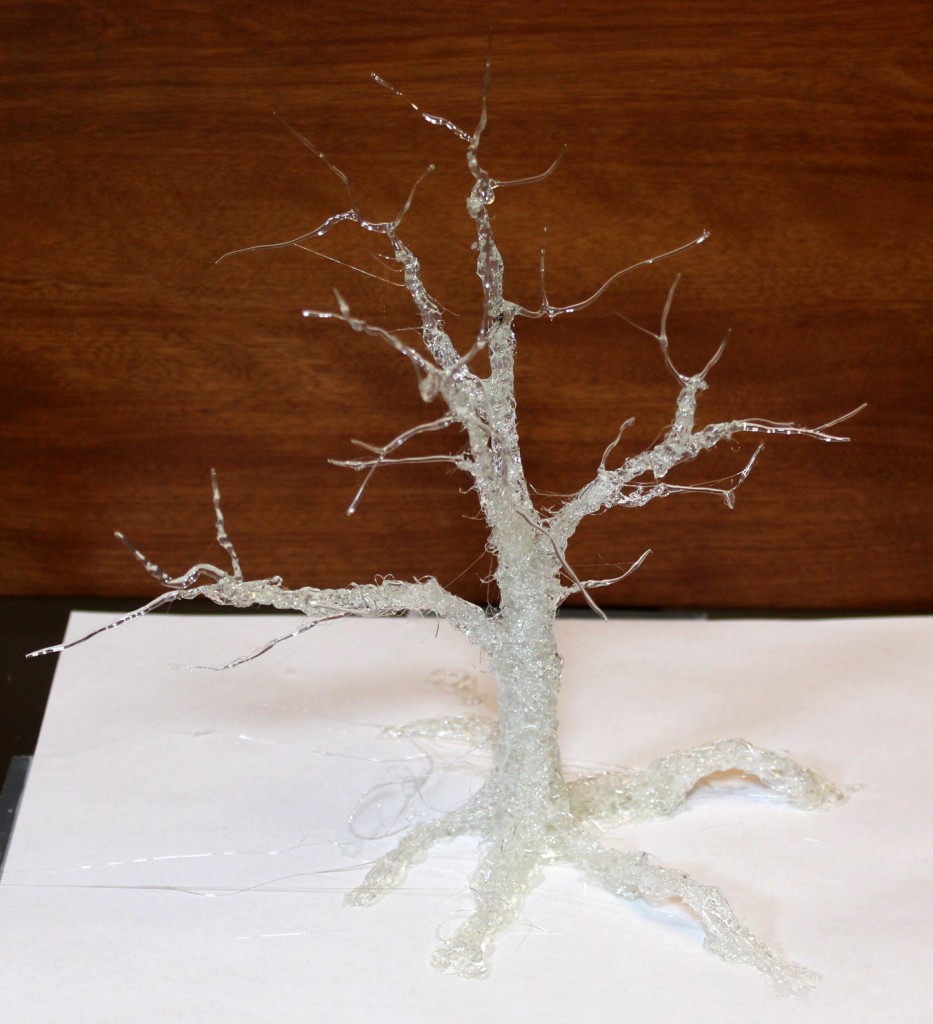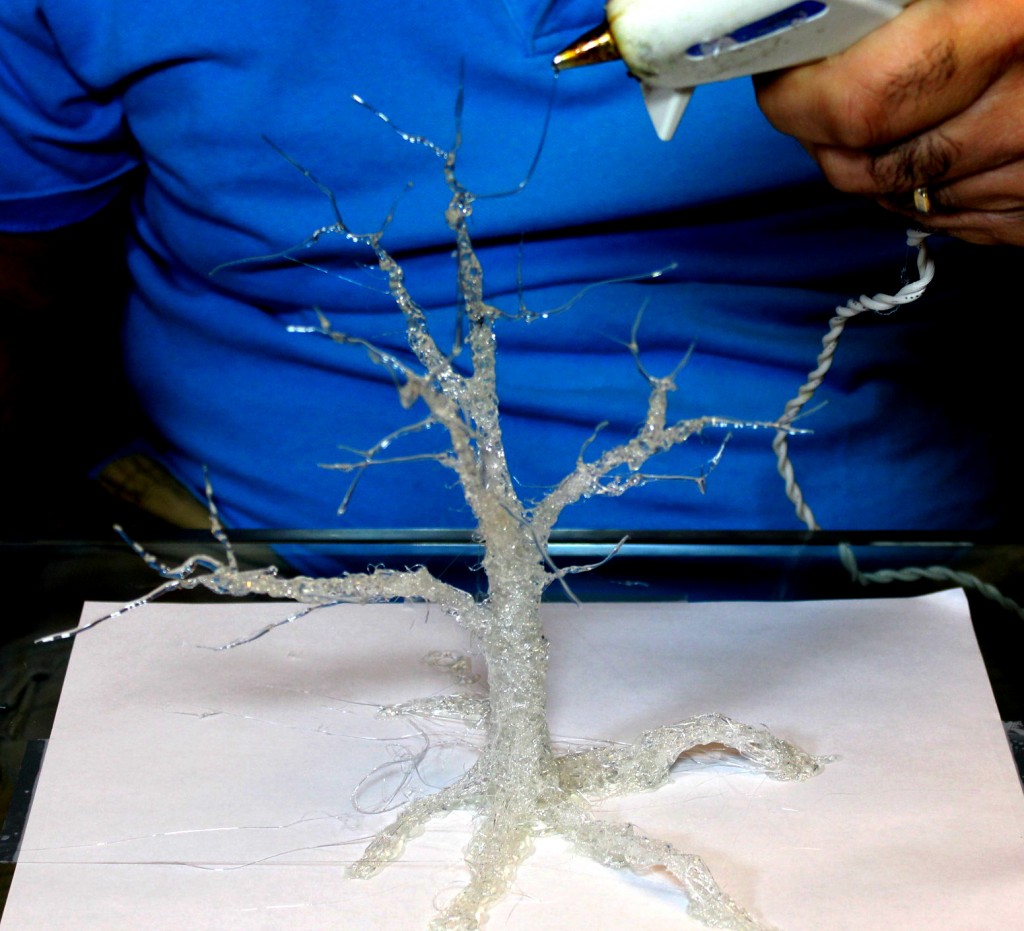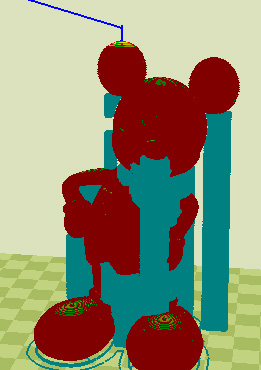3D printing is quite a simple concept, but very effective in making parts nowadays. You can easily do it at home:
I did have a hard time using my hot glue gun to print a tree. But there is definitely a benefit to that method that you can be creative and go in any direction. This concept is used in 3D Printer pens. I will definitely buy one of those for my daughter. I think you can be very creative with those. Below is my tree:


Like I mentioned in the video, 3D printing is done like a hot glue gun. The printer head has to get very warm, mostly above 200 degrees Celsius depending on the material used for printing. Mostly some sort of plastic is used for printing, which melts under such temperatures. The head pushes the molten material out on the printer bed layer after layer to form the desired 3D object. The material dries very quickly after it is out of the head.
The printer bed also gets quite warm (less than the head) so that the material remains sticky and adheres to the bed well. This prevents the model to move around while being printed.
My 3D printer is a LULZBOT MINI that uses a software called Cura to manage the printer. In that software you can load a 3D model and go through the layers that will be printed and see if corrections are needed to your model. This software cannot edit 3D models but is a very good tool to double check and see if your model will be printed correctly. You would need another software for modeling 3D. I use Sketchup because it is free and very simple and effective for newbies like me. In the video below (make sure to allow the plugin to run) you can see the layers which the printer will print one by one to achieve the final object.
Now understanding the fact that printer can do one layer at a time, you soon realize that printing over-hanging objects like tree branches would be an issue. Although the over hanging object will be eventually attached to the main body, printer may have to start printing it before the connection to the main body, which means that part in the layer will be floating in mid air! So in order to print such a thing, the printer needs to print a support structure the hold the floating parts in the air until they attach to the body in the upper layers. The picture below shows the support structures in blue:

Support Structure for Over-Hanging Parts
The support structures are printed such that they are attached to the model with very thin strips of material that can easily break away after the printing is done with minimal residue that can be easily cleaned up.
I haven’t printed much so far, but below I list my early wisdom on 3D printing so you can startup easier with the printing:
- Be patient! 3D printing will take many hours.
- Make sure you check all the layers to be printed in the printer software (like Cura) to ensure all layers will be printed as you want them too.
- Make sure you have loaded the material as mentioned in the manual and try to push a bit of it out controlling through the printer software (when the head is hot of course) to ensure there are no bobbles or craziness there in the head.
- You don’t need support structure if you don’t need overhanging objects. But you can’t print without support structure if you have overhanging objects. Make sure any horizontal or close to horizontal surfaces have support structure. You must understand that the hot material is soft and before it dries it cannot be held straight without support.
- Don’t worry, the support material is usually printed very thin and is a small fraction of the total material used. It’s worth having it in many cases.
- The material you use can have a big effect on the quality of the outcome. For example, HIPS by eSUN is a cheap and strong material and good for rapid prototyping. But even at best resolution it ends up rough. It is also used as support structure in printers that can print two materials at the same time. But the more expensive nGEN by colorFabb is a material that ends up very fine and shiny and beautiful! That’s what I used to print my rockets. These materials both use the same setting. But remember even with the best printer resolution you still see the printed layers, which is fine in my opinion.
- Make sure you adjust your setting depending on the material used (bed and head temperature).
- Some people use an acetone vapor bath and put the printed model in a closed container with acetone vapor for some time. The vapor melts the surface of the model, gets rid of its rough surface and makes it nice and smooth. I haven’t tried it though.
- By the way as you see in the video, I printed the rockets in a special manner:
- I printed the fins separately, because I predicted the printer would have difficulty printing such fine fins vertically, but it would be easy to print them if they were laid flat on the surface. Then I glued them with crazy glue afterwards.
- The bottom of the rockets sitting flat on the bed had a small surface contact. I was worried that due to the large height to bottom surface ratio of the rockets, it would be easy for the printer head to drag the rockets around, disconnect them from the bed or screw up the layers during printing. So I connected the rockets to a flat plain sitting on the bed, that would adhere nicely to the bed to avoid disconnection, and I also connected my four rockets in the middle with a rod so that they can support each other more. Of course for the rod to print I needed to print a support structure too. See video for how the 3D model looked like.
- Printing very fine objects like tall and thin vertical structures can be challenging to the printer. Especially if the printer is only making that structure (not leaving it to work on another surface). The smaller the layer to be printed is, the less time it takes to be printed and so the head will start the new layer before the previous layer is fully dry and that can drag the layers around and makes them look rough. Adjusting the printer speed for small objects, as well as the printing speed for inner and outer traces in one layer can help improve this. With Cura software you can change settings at different printing heights that can improve the quality. But you need to become an expert to adjust those, or google!
